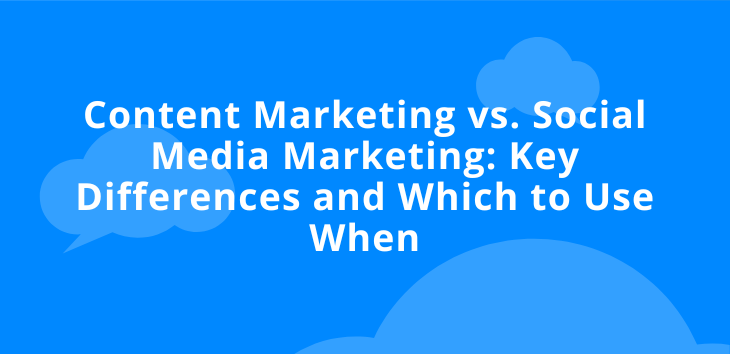Conversations about both content marketing and social media marketing continue to dominate the digital marketing landscape. However, many people still confuse the two, often mistaking one for the other. Some even treat them as identical, using both terms interchangeably.
In actuality, content marketing and social media marketing are two very different disciplines. But they do overlap, support, and complement one another in some fascinating ways. They’re also both essential parts of any thorough digital marketing strategy.
In this comprehensive guide to content marketing vs. social media marketing, we’ll touch on everything you need to know to knock your marketing goals out of the park. We’ll cover the differences between the two and let you in on some best practices for knowing when and how to apply each.
What is the Difference Between Content Marketing and Social Media Marketing?
Content marketing and social media marketing each play unique roles in reaching audiences. Content marketing is about crafting and sharing informative materials like blog posts, videos, and ebooks, usually on your own website. It aims to educate and engage specific groups over time. The goal is to build authority and trust by providing valuable content that appeals to potential customers’ interests and needs.
On the other hand, social media marketing focuses on creating content tailored for platforms like Facebook and Instagram to interact directly and instantly with users, sparking conversations and building community. While both strategies aim to boost brand awareness and engagement, they target audiences and achieve their goals in different ways.
Both content and social media marketing serve your business goals by raising brand awareness, contributing to conversions, and putting your brand in front of target audiences. However, each does this in its own unique way:
- Marketing content most often lives on your website (or possibly someone else’s), while social content is created specifically for individual platforms like Facebook, X (formerly Twitter), or Instagram.
- Content marketing is about educating and influencing an audience, while social media marketing is about engaging audiences and starting conversations.
- Social content is typically ephemeral and short-term, while marketing content is usually long-form, in-depth, and crafted to be useful over the long term.
- Content marketing builds authority and trust, while social media marketing humanizes brands and makes them more relatable.
In other words, content marketing is more about long-term engagement and building trust through valuable information, while social media marketing focuses on immediate interaction and community building. The two concepts complement one another greatly, and you need both to make your marketing strategy work in today’s ever-changing digital landscape. However, this doesn’t change the fact that content and social media marketing are distinctly different.
What is content marketing?
Content marketing is a strategic discipline that involves planning, crafting, publishing, and distributing targeted content to serve an audience, drive sales, and attract new customers while retaining existing ones. This marketing discipline involves a detailed process of planning, developing, and sharing content through various formats including blog posts, ebooks, videos, podcasts, infographics, and long-form articles. This is done to engage potential and existing customers by offering useful content that meets their needs and interests.
What is social media marketing?
Social media marketing is the process of planning, creating, and posting content across one or more social media platforms to connect with target audiences in a personable, accessible way. Specific posts may aim to promote products, drive traffic, initiate conversations, build community, and make the brand appear more relatable and human.
Content Marketing and Social Media Marketing Have Different Objectives
All marketing strategies and tactics have clear, actionable goals, and this is just as true for social and content marketing.
Again, there’s some overlap between the two. Many marketers may even track and analyze the same key performance indicators (KPIs) to evaluate the success of both. However, the primary underlying objectives are different.
Content marketing emphasizes the funnel and lead generation
The primary focus of content marketing is to draw potential customers into the sales funnel and guide them through buyer’s journey. By providing valuable, relevant content at each stage of the funnel, content marketing helps nurture leads, builds trust and strengthens budding brand-client relationships.
Here are a few examples of some of the many ways this can look:
- Well-crafted blog posts, videos, or infographics—especially those with viral potential—attract and educate potential customers.
- Top-tier gated content like ebooks and whitepapers can generate high-quality leads at the top of your sales funnel.
- Robust email marketing content and ongoing blog content answer consumer questions and influence decisions as they navigate the middle of your funnel.
- Advanced content like webinars, how-to guides, online courses, and similar resources help establish the brand’s authority in the field and deepen trust with the audience.
This strategy requires high-quality copy to succeed, and services like Crowd Content provide robust copywriting solutions tailored to meet diverse goals across different niches and industries. From crafting detailed blog posts for content marketing or engaging tweets for social media, professional copywriting services can truly elevate your brand’s marketing efforts.
Social media marketing emphasizes direct engagement with audiences
These days, social media is more than just a way to stay in touch with friends or kill a few minutes while waiting in line for coffee. It’s an important part of how consumers research purchase decisions and become aware of new product options. For that reason, a solid social media strategy is a key way for today’s brands to engage with existing and potential customers.
Here are some examples of how brands like yours leverage social platforms to satisfy this objective:
- Eye-catching social media posts draw attention as people scroll through their feeds, stopping them in their tracks and introducing them to new products or brands. This can make a memorable impact in a brief interaction.
- Successful posts start conversations, encourage sharing, and boost engagement rates. They broaden brand reach through compelling questions, call-to-action prompts, and interactive content like polls and quizzes.
- Becoming a regular presence on consumers’ social media feeds boosts brand awareness and raises the chance of a potential future purchase. This consistent visibility keeps the brand top-of-mind.
- Social media and regular engagement help humanize your brand and make it relatable.
- Many brands use social media to field customer service issues and address concerns directly. This helps in resolving issues efficiently and improves customer satisfaction and loyalty by showing that the brand is attentive and responsive.
Which is Better: Social Media Marketing or Content Marketing?
Neither social media nor content marketing is definitively better than the other across the board. However, content marketing is better suited to long-term business strategies, while social media is ideal for more immediate results. A complete digital marketing strategy includes both and uses them in a way that complements one another.
Targeting audiences with content marketing vs. social media marketing
Both social media and content marketing require marketers to truly know their audiences. Market research, customer feedback, and tools like buyer personas can really help you here. However, how you apply these to your targeting efforts will vary.
- SEO is an audience-targeting staple with both types of marketing. Both leverage well-researched keywords to boost visibility in relevant search results. However, content marketing SEO revolves heavily around long-tail keywords and natural language processing, while social media SEO involves elements like hashtags for content discoverability and engagement.
- Content variety matters with both content marketing and social media marketing. However, while content marketing spans a wide array of formats, from written content to videos to podcasts, social media marketing will likely use a variety of content types suited for quick consumption (e.g., short videos, images and concise text posts).
- Techniques like audience segmentation are significant in personalizing marketing content and delivering the right options to the right people. With social media marketing, knowing how to create effective social media posts to suit individual platforms and playing the algorithm helps serve your posts to the right folks.
- Paid advertising can be helpful in both types of marketing to support ongoing organic efforts and drive quick bursts of traffic as needed.
Content marketing and social media marketing engagement models
Although driving engagement is one of the primary objectives behind social media marketing, it’s still essential in content marketing. Engagement can be any interaction an audience member has with a piece of your content. Examples include likes, comments, social media shares, link click-throughs, subscription sign-ups, and long dwell times.
Methods for driving engagement across both types of marketing include examples like the following:
- Investing in dynamic content that stops people in their tracks and demands attention, including unique social media posts, in-depth blog content, and exciting videos
- Inviting audiences to participate in top-tier interactive experiences to boost information retention and brand recognition
- Leveraging social proof like user-generated content, testimonials, and case studies to enhance credibility and trustworthiness
- Actively inviting readers and followers to offer their feedback, occasionally offering incentives in exchange for doing so
- Outsourcing portions of the content production process to streamline workflows while keeping quality high
Techniques and approaches like these work, and numerous case studies prove it. Here’s a brief overview of a couple to consider as you plan your next marketing move.
INK’s traffic success story
INK was looking for a way to show rather than tell their customers that their content optimization tool can move mountains in SEO, so they turned to Crowd Content for help.
We worked with them to craft a strategy that involved creating a series of fully optimized blog articles and measuring the results to create impressive proof that INK’s tools perform as advertised. As a result, INK saw an incredible 1700 percent increase in blog traffic in just over a month.
GLOBO’s success with content variety
Variety is more than just the spice of life. It also lends flavor and interest to your collective digital marketing campaign. The language-support company GLOBO needed help with its messaging and encouraged more readers to become service subscribers.
Creating a strategy that tailored content to cater to customers at various stages of the sales funnel worked. GLOBO’s website views jumped by 200 percent, and brand messaging improved accordingly.
Craftjack’s smart use of outsourcing
When keeping up with your ongoing marketing demands is more than your team can handle on its own, outsourcing content can be a fantastic option to consider. Lead-generation company Craftjack needed a go-to way to keep their marketing content flowing smoothly but couldn’t handle the job alone.
Partnering with Crowd Content gave Craftjack instant access to experienced niche writers, skilled project managers, and eagle-eyed editors who banded together to boost production. Craftjack was even able to connect with skilled Spanish-language writers to better reach another sector of their client base. The result was a 70 percent increase in organic traffic over a year.
When to use content marketing
Brands can lean into content marketing at any stage of the sales journey to help accelerate progress toward goals, connect with new customers, and keep existing audiences engaged. Some objectives that would make that an excellent choice include:
- Establishing industry expertise and authority
- Raising overall brand visibility, primarily via Google and other search engines
- Elevating SEO rankings and staying competitive on key search engine results pages (SERPs)
- Drawing new users and readers into the top of your sales funnel by showing how your brand can solve their problems
- Strengthening existing relationships by delivering valuable ongoing solutions
You can brainstorm and create better, more effective marketing content by implementing strategies and best practices like the following:
- Deliver value that goes above and beyond what your competitors are doing. Demonstrate how your products and services can uniquely solve problems and improve your customers’ lives.
- Use tools like surveys and buyer personas to develop a deeper understanding of your audience’s preferences, challenges, and behaviors. This will allow you to tailor your content more effectively to meet their needs.
- Create a detailed content calendar and follow it to the letter to keep your content efforts focused and the quality consistent.
- Offer lots of variety to keep your content flow fresh. Think videos, infographics, webinars, podcasts, and ebooks in addition to standard fare like blogs.
- Extend the reach and lifespan of your most successful content by updating it with the latest information and repurposing it into different formats. For example, a popular blog post can be turned into a video tutorial or an infographic that allows you to reach a broader audience.
When to use social media marketing
Social media marketing is a solid way to stay perpetually connected with your customers and create exciting ongoing conversations about your brand that attract plenty of fresh leads. Business objectives that call for a greater focus on social media marketing include:
- Identifying demographics and markets that could be a solid fit for your products
- Embracing cost-effective ways to get more eyes on your marketing content and drive traffic to your website
- Generating useful analytics that can help you optimize your entire marketing strategy
- Engaging directly with your audience on a one-to-one basis
- Providing better, faster, more robust customer care options
- Building overall brand awareness and recognition
Make the most of your social media marketing efforts by considering best practices like the following and looking for ways to integrate them into your strategy:
- Meet your audience where they live by building a presence on the platforms they frequent most.
- Fine-tune your approach to social media marketing to suit each platform. What works like gangbusters for Facebook posts may not resonate the same way with your TikTok audience or your Instagram strategy.
- Explore influencer marketing to tap into readymade audiences that fit your products and services perfectly.
- Encourage and share user-generated content to show social proof that people already love what your brand is doing.
- Chime in on hot topics and trends related to your industry or niche. This keeps your content fresh and relatable, and can help attract new followers who are interested in those topics.
Examples of Content Marketing and Social Media Marketing
Remember that neither content nor social media marketing is about just one thing. Creative, novel approaches that combine multiple approaches often yield the best results. Here are some popular examples of approaches to content marketing:
- Blog posts
- Email marketing
- Ebooks
- Infographics
- Videos
- Podcasts
- Webinars
- Whitepapers
- Case studies
- Interactive content experiences
Popular approaches to social media marketing to mix, match, and try include:
- Influencer marketing
- Community creation
- Contests and giveaways
- User-generated content
- Sponsored social media posts
How Can Content Marketing and Social Media Marketing Work Together?
Content marketing and social media marketing work hand in hand to boost your digital strategy. Sharing your blog posts, videos, and other content on social platforms not only increases visibility but also engages your audience effectively. Social media offers a direct way to gather quick feedback and encourages your followers to share their own content, increasing engagement further. By combining these strategies, you can leverage each to maximize your reach and interaction, making your marketing efforts more dynamic and effective.
Here are a few key examples of how content marketing and social media marketing go together as beautifully as peanut butter and jelly:
Promoting marketing content
Leveraging your reach on social media is an effective way to amplify the reach of your content, make audiences aware of new product drops, etc. Share articles, your latest blog posts, etc. Content like infographics and videos translate exceptionally well to engaging social media shares and extending your visibility beyond your immediate followers.
Zeroing in on an audience’s wants and needs
Social media is a fantastic way to acquire valuable feedback on what your audience really thinks. You can ask them directly for feedback on specific products, ideas, or content. You can also utilize solutions like social listening tools to follow conversations about your brand across multiple platforms.
Getting audiences involved
Your audience is likely one of your arsenal’s most powerful untapped marketing resources. Mobilize them by encouraging them to create and share user-generated content like photos or videos on social media, asking them to share your content to their feeds, etc.
Effective Strategies for Leveraging Both Content and Social Media Marketing
Investing in your content marketing and social media marketing campaigns separately is a solid start to making the most of both. Combining these two strategies can result in a more cohesive and powerful marketing approach. Here are some expert strategies to try.
Keep your tone cohesive across both
Brands are just like people in that each has its unique personality, voice, values, and approach to connecting with others. It’s crucial that those characteristics are consistent across all platforms. This consistency ensures that your audience receives a unified brand experience, regardless of where they interact with your content..
For example, a customer should be able to visit your Facebook page or X profile and consume content there that “feels” the same as what they’re already reading on your blog or in your email newsletter. If that’s not the case for your brand, now is the time to tighten things up. Check out how brands like Wendy’s, Go Pro, or Nike handle this and get inspired.
Integrate both into your content calendar
Thorough planning as far in advance as possible is the key to an ongoing content strategy that really cooks. Content calendars take the guesswork out of managing, planning, and creating content, especially as your business grows and you take on additional team members to help with various tasks.
Include both your marketing content and your social media posts. Identify opportunities to combine the two in creative ways that serve your audience. As always, ensure that everything you plan fully aligns with your brand voice and company values.
Cross-promote content where it makes sense
Social media posts and standard content work better together than you might think, and there are plenty of opportunities for cross-promotion.
For example, you can promote your latest blog posts and product launches across your social media channels using engaging visuals like screenshots, infographics, or custom imagery to grab attention and add value. You can also embed tweets and YouTube videos or add screen grabs of various social media posts to add visual interest to your blog posts and written content.
Find creative ways to repurpose content
Keeping multiple content channels and social media profiles perpetually filled with terrific content is no easy feat, so it pays to do what you can to make your best ideas go as far as possible. Content repurposing is one highly effective way to do that.
Here are some examples of how creative content repurposing can work:
- Break down YouTube videos and how-to guides into graphic sequences you can post to Instagram.
- Sum up key points and important takeaways from popular informative blogs in an infographic you can share on Facebook, Pinterest, X, or Threads.
- Expand your best long-form blogs into ebooks and use social media to promote them.
- Repurpose long-form content into social media-friendly short-form videos.
- Translate a popular webinar or e-course into a series of Instagram reels or TikTok videos.
Hire experts to help you
As your business grows and the demands on your content strategy increase, considering outsourcing to maintain quality and innovation can be beneficial. Some people purchase pre-written articles to help fill in crucial content gaps.
You can also hire a trusted full-service content creation service like Crowd Content to help you with the entire process. We’ll help you manage the workload and inject fresh ideas into your strategy. We’ll also provide assistance that cover everything from dynamic web content to engaging social media posts to expert content management.
Benefits of Integrating Social Media Insights into Content Strategies
Insights gained from your experiences engaging with audiences on social media can be priceless assets when it comes to fortifying your content marketing strategies. You can get a read on what your audience truly likes and dislikes, as well as how they feel about various content approaches. You can then apply what you learn to reap benefits like the following.
Higher engagement rates
When you know for sure what your audience is genuinely into, you can apply what you know to create more of the kind of content your customers like best and find most useful. Applying these insights allows you to tailor your content more precisely, producing material that not only attracts attention but also encourages interaction.
Stronger brand loyalty
Think of someone you know who’s always there for you—who always has the right answer to your questions and the best advice on a particular topic. You trust them, and you’re loyal to them, too. That’s how consumer relationships with brands develop through similar dynamics, and using social media insights wisely can help that happen for your business.
Improved SEO
Forms of social media-related engagement like shares are powerful signals to search engines that a brand is putting exceptional content out there. Using what you learn about your customers on social media to boost engagement drives traffic to your website and enhances your greater SEO efforts.
Higher overall ROI
Both content marketing and social media marketing represent investments in your business. It’s not just about money or budgets, either. Time, labor, and mental energy are resources, too, so facilitating a high return on that investment is crucial. Integrating social media insights into your strategy can help you hit the right notes more often, sending your ROI through the roof.
Budgeting for Each Approach
No two brands are exactly alike, and neither are any two approaches to digital marketing, so costs can vary for individual campaigns. However, average costs range between $6,000 and $60,000 a month for a content marketing campaign and between $500 and $5,000 per month for a basic social media management campaign.
Opting for a scalable approach via a company like Crowd Content can ensure you get the most bang for your buck right out of the gate and on an ongoing basis.
Ultimately, neither content nor social media marketing fits your company’s digital marketing strategy better. You need both to stay competitive and keep your finger on the pulse of what modern audiences are looking for. Exploring opportunities to leverage how they complement one another can eliminate the confusion of both processes.
Ready to dive into your future success and get more out of your marketing strategies? Let Crowd Content help you fill in the gaps and create something truly dynamic with quality content services on demand.




